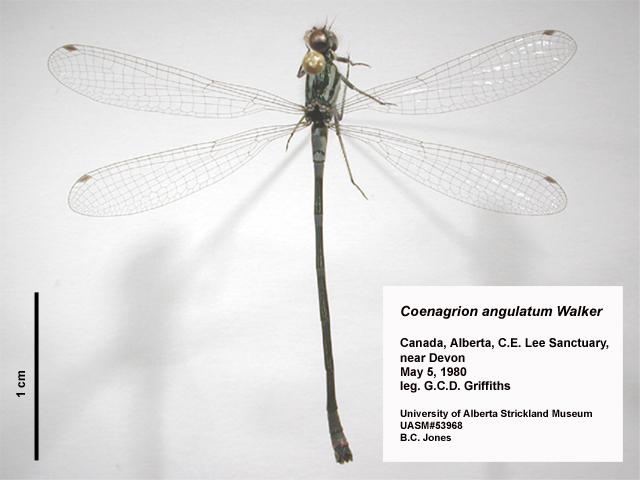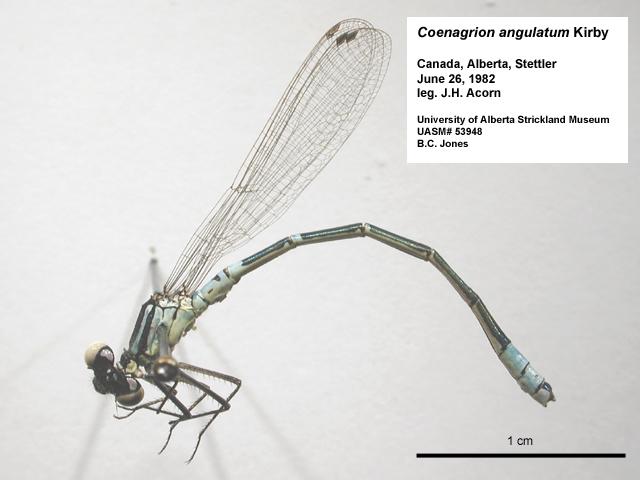Species Details
Coenagrion angulatum
University of Alberta E.H. Strickland Entomological Museum Read more about this collection »
Common NamePrairie bluet
SeasonalityAdults fly from late May until early August, later in the southern part of its range.
IdentificationThe prairie bluet is more robust and darker blue in colour than the other Eurasian bluets (C. interrogatum and C. resolutum) found in North America (Walker 1953). Males have a distinct colour pattern on the abdomen; segments 3 to 7 are black with blue bands that become progressively smaller towards the end of the abdomen. The end of the abdomen is almost completely blue (Walker 1953, Acorn 2004). Males also have a distinctive black spot on the top of the second abdominal segment and slightly widened terminal abdominal segments (Westfall and May 1996). Female colours are usually yellow-green to tan but can be blue like the males (Westfall and May 1996). Abdominal segments 3 to 7 are dark without coloured rings and segment 8 has pale colouration on top at the base (Walker 1953, Acorn 2004). The dorsal surface immediately behind the head on females has three lobes on the posterior margin; the middle lobe projects above the other two (Walker 1953). Prairie bluets are small damselflies, rarely exceeding 3 cm in length.
Larvae of the prairie bluet are difficult to distinguish from the other Eurasian bluets or even American bluets (genus Enallagma) or forktails (genus Ischnura). The prairie bluet has no obvious characters that allows for identificaion in the field. Coenagrion larvae are of average stature with the posterior margin of the head rounded and eyes not very prominent (Walker 1953).
Scientific Name
Coenagrion angulatum
Common Name
Prairie bluet
Habitat
Prairie ponds and sloughs, slow moving streams.
Seasonality
Adults fly from late May until early August, later in the southern part of its range.
Identification
The prairie bluet is more robust and darker blue in colour than the other Eurasian bluets (C. interrogatum and C. resolutum) found in North America (Walker 1953). Males have a distinct colour pattern on the abdomen;…
The prairie bluet is more robust and darker blue in colour than the other Eurasian bluets (C. interrogatum and C. resolutum) found in North America (Walker 1953). Males have a distinct colour pattern on the abdomen; segments 3 to 7 are black with blue bands that become progressively smaller towards the end of the abdomen. The end of the abdomen is almost completely blue (Walker 1953, Acorn 2004). Males also have a distinctive black spot on the top of the second abdominal segment and slightly widened terminal abdominal segments (Westfall and May 1996). Female colours are usually yellow-green to tan but can be blue like the males (Westfall and May 1996). Abdominal segments 3 to 7 are dark without coloured rings and segment 8 has pale colouration on top at the base (Walker 1953, Acorn 2004). The dorsal surface immediately behind the head on females has three lobes on the posterior margin; the middle lobe projects above the other two (Walker 1953). Prairie bluets are small damselflies, rarely exceeding 3 cm in length.
Larvae of the prairie bluet are difficult to distinguish from the other Eurasian bluets or even American bluets (genus Enallagma) or forktails (genus Ischnura). The prairie bluet has no obvious characters that allows for identificaion in the field. Coenagrion larvae are of average stature with the posterior margin of the head rounded and eyes not very prominent (Walker 1953).
Life History
Sawchyn and Gillott (1975) performed a detailed study on the biology of prairie bluets in Saskatchewan. Females lay soft, creamy-white eggs during June and July in cuts made in living, aquatic plant tissue. Embryonic…
Sawchyn and Gillott (1975) performed a detailed study on the biology of prairie bluets in Saskatchewan. Females lay soft, creamy-white eggs during June and July in cuts made in living, aquatic plant tissue. Embryonic development takes 2 to 3 weeks. Larvae develop rapidly and near completion by October. Larvae over-winter in one of the final three stages (instars) of development, frozen in the ice that forms in their shallow habitat. The larvae intentionally place themselves where they become embedded in the ice but do not freeze. The larvae remain dormant until April when the ice melts and then continues development. This adaptation likely does not occur throughout the prairies bluets range. Larvae leave the water to become adults by mid-June. Newly emerged adults disperse from the larval habitat to feed and mature. Maturation requires about 1 week and mating occurs away from the water, oviposition occurs within 2 weeks of adult emergence. Oviposition occurs with the male still attached to the female. Eggs are always deposited below the water surface on floating or emergent vegetation. Baker and Clifford (1981) report that taiga bluets can take two years to complete their life cycle; this is likely the case with prairie bluets.
Conservation
Not currently a concern. Prairie bluets are abundant throughout their range.
Diet Info
Adults feed on flies (e.g. midges) (Sawchyn and Gillott 1975). Larval diet is likely similar to that of the taiga bluet, which feed on, fly larvae, water fleas, other odonate larvae and assorted invertebrates (Baker…
Adults feed on flies (e.g. midges) (Sawchyn and Gillott 1975). Larval diet is likely similar to that of the taiga bluet, which feed on, fly larvae, water fleas, other odonate larvae and assorted invertebrates (Baker and Clifford 1981).
Range
Prairie bluets can be found from the western edge of Ontario as far west as northeast British Columbia (e.g. Peace River area). There are records from the southern edge of the Northwest Territories to the…
Prairie bluets can be found from the western edge of Ontario as far west as northeast British Columbia (e.g. Peace River area). There are records from the southern edge of the Northwest Territories to the north-central states (e.g. Minnesota, South Dakota) (Walker 1953).
References
Author
Acorn, J.
Title
Damselflies of Alberta.
Publication Date
2004
Pages
156 pp
Author
Westfall, M. J. Jr. and M. L. May
Title
Damselflies of North America.
Publication Date
1996
Author
Baker, R. L. and H. F. Clifford
Title
Life cycles and food of Coenagrion resolutum (Coenagrionidae: Odonata) and Lestes disjunctus disjunctus (Lestidae: Odonata) populations from the boreal forest of Alberta, Canada.
Publication Date
1981
Series Title
Aquatic Insects
Volume
3
Pages
179-191
Author
Sawchyn, W. W. and C. Gillott
Title
The biology of two related species of Coenagrionid dragonflies (Odonata: Zygoptera) in western Canada.
Publication Date
1975
Series Title
The Canadian Entomologist
Volume
107
Pages
119-128
Author
Walker, E. M.
Title
The Odonata of Canada and Alaska
Publication Date
1953
Pages
307 pp
Specimen Information
There are 11 specimens of this Species.
UASM53945 - Coenagrion angulatum
University of Alberta E.H. Strickland Entomological Museum
Place CollectedCanada: Alberta, Red Deer
Collected ByWhitehouse, F. C.
Date Collected1916-07-06
UASM53946 - Coenagrion angulatum
University of Alberta E.H. Strickland Entomological Museum
Place CollectedCanada: Alberta, Red Deer
Collected ByWhitehouse, F. C.
Date Collected1916-07-08
UASM53947 - Coenagrion angulatum
University of Alberta E.H. Strickland Entomological Museum
Place CollectedCanada: Alberta, Red Deer
Collected ByWhitehouse, F. C.
Date Collected1916-07-08
UASM53948 - Coenagrion angulatum
University of Alberta E.H. Strickland Entomological Museum
Place CollectedCanada: Alberta, Stettler
Collected ByAcorn, J. H.
Date Collected1982-06-26
UASM53949 - Coenagrion angulatum
University of Alberta E.H. Strickland Entomological Museum
Place CollectedCanada: Alberta, Devon
Collected ByAcorn, J. H.
Date Collected1981-05-25
UASM53950 - Coenagrion angulatum
University of Alberta E.H. Strickland Entomological Museum
Place CollectedCanada: Alberta, Alix
Collected ByAcorn, J. H.
Date Collected1981-05-21
UASM53952 - Coenagrion angulatum
University of Alberta E.H. Strickland Entomological Museum
Place CollectedCanada: Alberta, George Lake
Collected ByFournier, J. D.
Date Collected1981-06-19
UASM53953 - Coenagrion angulatum
University of Alberta E.H. Strickland Entomological Museum
Place CollectedCanada: Alberta, Clifford E. Lee Sanctuary
Collected ByGriffiths, G. C. D.
Date Collected1980-06-13
UASM53954 - Coenagrion angulatum
University of Alberta E.H. Strickland Entomological Museum
Place CollectedCanada: Alberta, Nordegg
Collected ByCollett, E. M.
Date Collected1955-07-10
UASM53955 - Coenagrion angulatum
University of Alberta E.H. Strickland Entomological Museum
Place CollectedCanada: Alberta, Edmonton
Date Collected1957-07
UASM53956 - Coenagrion angulatum
University of Alberta E.H. Strickland Entomological Museum
Place CollectedCanada: Alberta, Winterburn
Collected ByHocking, B.
Date Collected1955-07-21



